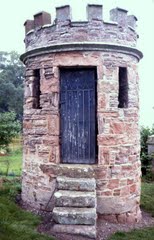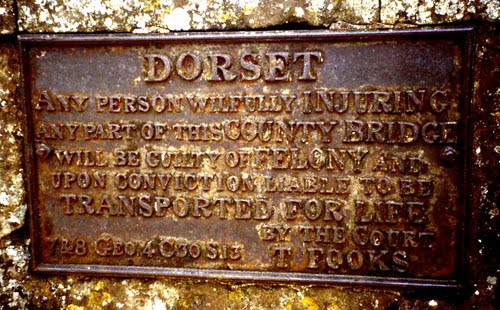HIGHWAY ROBBERY
A tomb grave in the churchyard at Prestbury in
Cheshire, records that
William Wyatt, 41 years, of Adlington, a quarryman, fell shot through the body
whilst gallantly taking the lead in the capture of two armed highwaymen in
Shrigley in 1848.
£100 was raised by
public subscription for his widow and children.
His brother Thomas was shot in the arm in the same incident.
The Three Houses, formerly called The Magpie, an old coaching inn at Sandal near Wakefield was one of three inns in the village. The Raven and The Plough both closed down and the Magpie was renamed The Three Houses. Highwaymen were once prevalent in this area. In those days of the 17th and 18th centuries when stagecoach travel was the order of the day, (as the Inn sign depicts), the predatory activities of the highwayman was one of the many hazards for such traveller John (or William) Nevison was one of the most notorious of these characters, a man renowned for his dash, ingenuity and fearlessness, he was probably born at Wortley near Sheffield in 1639. Although Nevison came from a good family, he stole from his family and soon left home. He stole a horse and rode to London where he obtained employment and for a couple of years it seemed that he had settled down, but then he stole £200 from his employer and disappeared with the police on his tail. He evaded capture and eventually enlisted as a soldier, serving in Flanders, but, ever the individualist, Nevison deserted and returned to his native land and became a highwayman. His notoriety soon earned him the soubriquet Swift Nick Nevison (Some say it was Charles 11 who used this name) with the reputation of aiding the poor. He rode and worked alone and reaped a rich harvest from the wealthy travellers on the southern highways until things became too hot for him and he moved back to his native Yorkshire where he was virtually unknown. As he continued his nefarious activities Nevison soon had the local law officers after him and it is said that it was whilst being closely pursued by constables on the road between Pontefract and Ferrybridge that he took his horse on an incredible leap between two cliffs, making good his escape. This chasm became known as Nevison’s Leap and was near to where a pub of that name is now situated. The story goes that Nevison was eventually caught and committed to Leicester Gaol, but escaped by pretending to have contracted the Plague. One of his friends,a physician, came and attested to his illness, and another friend, a painter, provided make-up. Nevison feigned death and was carried out of the gaol in a coffin. His subsequent reappearance on the highway was at first taken to be ghost sighting. Out of character and as an act of self preservation he shot and killed a constable, Darcy Fletcher, who had a warrant for his arrest. This increased the pressure upon the authorities to ensure his capture. It appears that he had joined a gang of highwaymen who operated from the Talbot Inn at Newark on the Great North Road. Stories of this audacious freebooter are legend and he usually managed to keep one step ahead of the law but his luck ran out in 1684 when he was found asleep in a chair at The Three Houses Inn. The chair can be seen in St Helen’s church at Sandal. He was arrested and tried for a variety of crimes including Fletcher’s murder and was hanged at York in that year. He was buried in an unmarked grave at St Mary’s Church, Castlegate, York. It was in fact Nevison who made the legendary run, wrongly attributed to Dick Turpin, from London to York. This able and accomplished horseman had been arrested and accused of committing a robbery near London at 4.0.clock in the morning. He was acquitted after proving that he was in York on the day in question, and had actually spoken to the Lord Mayor at 7.45pm. Nevison later boasted that he had made the amazing ride of 209 miles to York in less than 16 hours after the robbery. It seems that although Nevison was dreaded by those liable to suffer at his hands, he was in fact a gentleman of the road, much respected by the poor to whom he was a good friend, and a contemporary ballad was written about him:
‘ Did you ever hear tell of that hero, Bold Nevison was his name.
He rode about like a bold hero, And with that he gain’d great fame.
He maintained himself like a gentleman, Besides he was good to the poor,
He rode about like a great hero, And he gain’d himself favour therefore.’
THE THREE HOUSES INN
Meanwhile at The
Green Dragon Inn at Welton near
Hull in East Yorkshire, now a quiet country pub, stories of the legendary Dick Turpin abound, for this was the
scene of his arrest in 1739. Turpin was
nothing like the romantic character portrayed by Harrison Ainsworth in his
novel Rookwood. He was actually born at
The Rose and Crown (formerly
the Bell Inn) at Hempstead in Essex and ended his days on the gibbet at York
Knavesmire on April 17th 1739. Turpin
was a cattle and horse thief turned highwayman and was actually detained at The
Green Dragon on a charge of poaching.
He gave the name John Palmer to avoid recognition but made the mistake
of writing to his brother whilst in custody and a former schoolmaster
recognized his writing. It seems strange
that Turpin could read and write, but apparently it proved to be his undoing
because he was duly identified, tried and hanged at York Knavesmire. He was just 34 years of age. It is said that Turpin engaged five indigent
men to follow his cart to the gallows and these ‘mourners’ were each paid the
sum of 10/-.
 |
THE GREEN DRAGON INN |
Dick Turpin was reputedly buried in the graveyard of
St. Georges Church in George Street, York, where a renovated gravestone reads :
‘ John Palmer, otherwise Richard
Turpin.
The notorious highwayman and horse stealer,
Executed
at Tyburn, April 17th, 1739
and
buried in St. Georges churchyard. ‘
Although Tyburn was
in fact the London gallows it was also a generic term for any gallows.
TURPIN'S GRAVE

The Cell is quite an appropriate name for the Old Manor
House at Markyate in Hertfordshire.
Built on the site of a former monastery, it was owned by the Ferrers
family from 1548 to 1660. Kathleen
Ferrers was born in 1634, and after an unhappy marriage when she was only 14
years old, she turned to crime as an escape from what she regarded as a boring
life.
At night she transformed herself
when she dressed in a three cornered
hat, black breeches and coat and then armed with pistols, she rode off along Watling Street on
her black horse, to hold up the coaches using that route. One night she was shot and seriously wounded
whilst holding up a coach. However, she
made her escape and managed to return to a secret room at The Cell. Sadly she died from her injuries but her
family hushed up the whole affair and she was subsequently buried with all the
pomp befitting her rank and status.
Despite the efforts of the family, the legend of ‘the wicked lady of Markyate Cell’ has persisted to the present time
and it is said that her ghost still appears in the area.
 |
THE CELL |















.jpg)






















